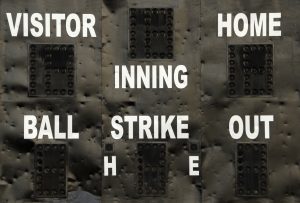Effective Estimating – Part 3 of 6
In the last Effective Estimating blog post, We talked about ‘What If’ scenarios, Managing Customer Expectations and then played around with an Excel model that could empower both of those worthy objectives. Today we will be spending some time talking about the place where America’s favorite pastime takes place, the Ballpark.
When it comes to effective estimating, the words every contractor and sub-contractor dreads to hear is “can you give me a ballpark estimate“. If you guess low, it’s the only number they remember. If you guess high, you may never see or hear from them again.
First lets take a look at the definition of the word Ballpark.
ballpark
“baseball stadium,” 1899, from (base) ball + park (n.). Figurative sense of “acceptable range of approximation” first recorded 1960, originally referring to area within which a spacecraft was expected to return to earth; the reference is to broad but reasonably predictable dimensions.
My response to this inquiry for a “Ballpark Estimate” always started with the statement, “the average cost of a ballpark is $750 million, will that fit in your budget?” which never failed to produce a laugh, and to open the door to a more serious conversation. Mission accomplished! Our best guess at the cost of a cabinet project is about as accurate as our best guess at the final score of next years World Series.
Don’t get me wrong here, I’m not opposed to Ballpark estimates, they are great pre-qualifiers (they get rid of the tire kickers), but I’m not a FAN (see what I did there? Ballpark – Fan) of a single number, nor a guessed at number. I always provided a RANGE like this (based on my companies 2011 results, so they would be higher today):
1. The least expensive project we produced last year ran $400.00 per cabinet, and you have approximately 20 cabinets, so the best case scenario is your project will cost $8,000.00.
2. The average cost for all our projects, taking everything from the least to the most expensive projects into consideration was $750.00 per cabinet, you have approximately 20 cabinets, so your project will probably fall somewhere close to $15,000.00.
3. The average cost per cabinet for the most expensive project we produced this past year was $1,500.00 per cabinet, so if your selections align with that project, your project could cost as much as $30,000.00.
This broad range of prices is based on the selections customers made over the previous year (doors, drawer fronts, drawer box type, functional hardware type, wood specie, finish, accessories, etc.), so it’s a good number (not a guessed at number). To do this, you simply divide your total sales for the previous year by the number of cabinets you manufactured. This is easy if you only manufacture and sell cabinetry, but if you also sell other things like counter-tops, you may need to start separating those ancillary things from your cabinet sales.
It may surprise some of my friends and acquaintances that as a technology advocate (technology made me money), I actually tracked these metrics on a physical calendar (many Certified True32 Custom Cabinetry Manufacturers can not only attest to this fact, but can probably tell you where I kept these calendars). I preferred loose sheets for each month as opposed to a printed calendar that was bound together into a year of pages, so I simply printed them from MS Word.
On these calendars, I would plan out my production schedule (pretty sure I would use Asana to do this today), always writing everything with pencil so it could move around when needed. My objective was to sell $20,000.00 of cabinetry each week (never achieved that goal for an entire year, but it was a lofty goal we did achieve and exceed on a month to month basis), so each months calendar would end up with the end result of what projects we manufactured that month, and I would simply add the number of cabinets sold for each project, the total sale in dollars to each projects listing, and at the end of each month, I would total up the cabinet quantity, total up the sales for the month, and divide total sales by cabinet quantity to get my averages for the month, and then add that months totals to my running totals, and the running totals would be added to the next months calendar to carry on throughout the year.
At the end of the year, I would go back through the calendars and find my lowest average cost project, and my highest average cost project, and those three numbers became my Ballpark Estimate Acceptable Range of Approximation for the next year.
Today we covered providing our prospective clients with multiple Ballpark Estimates in an attempt to to separate the wheat from the chaff. In our next article in this Effective Estimating series, we will look at doing something similar with our Formal Estimates to help us sell more projects.
To make sure you won’t miss a crucial part of this discussion, enter your email address in the ‘Subscribe to Blog via Email’ field on the right, and each time one of us adds a blog post, you will automatically be notified. Oh, and you won’t hurt our feelings if, depending on where you are seeing this, you Share, Like, Plus or Re-tweet it (there are buttons somewhere on this page to help you with that).
May the Lord bless the work of your hands, heart and mind.
